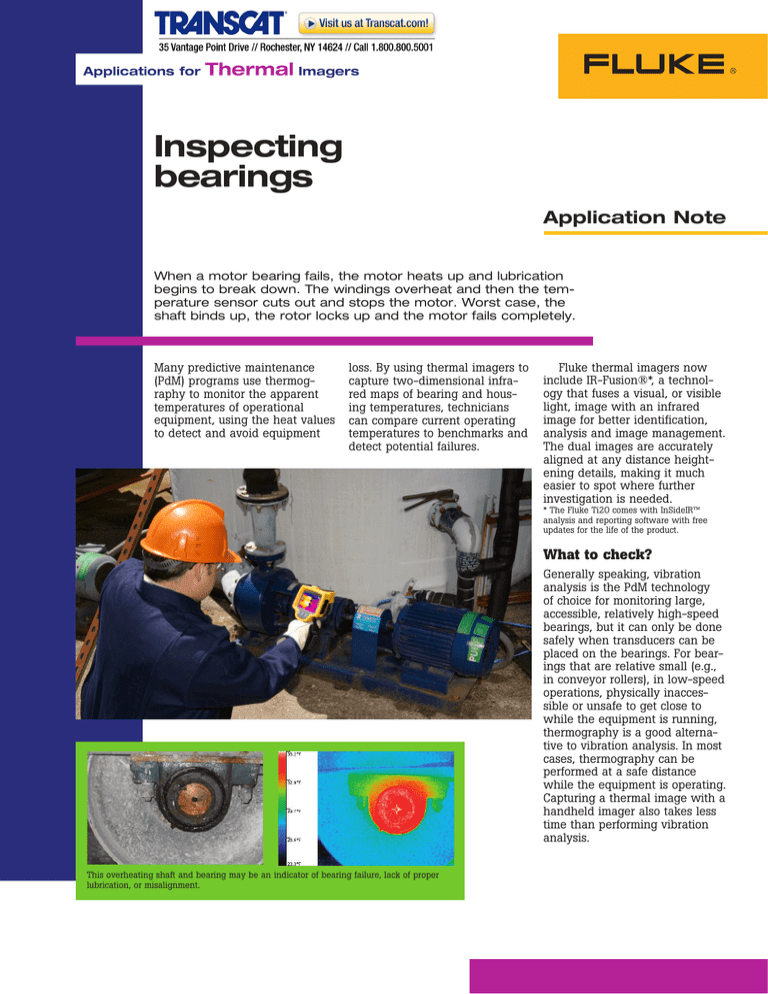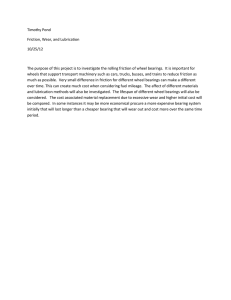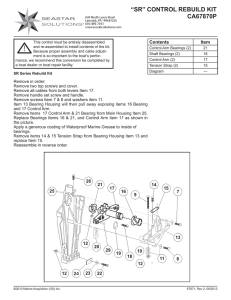Fluke Inspecting Bearings
advertisement

Applications for Thermal Imagers Inspecting bearings Application Note When a motor bearing fails, the motor heats up and lubrication begins to break down. The windings overheat and then the temperature sensor cuts out and stops the motor. Worst case, the shaft binds up, the rotor locks up and the motor fails completely. Many predictive maintenance (PdM) programs use thermography to monitor the apparent temperatures of operational equipment, using the heat values to detect and avoid equipment loss. By using thermal imagers to capture two-dimensional infrared maps of bearing and housing temperatures, technicians can compare current operating temperatures to benchmarks and detect potential failures. Fluke thermal imagers now include IR-Fusion®*, a technology that fuses a visual, or visible light, image with an infrared image for better identification, analysis and image management. The dual images are accurately aligned at any distance heightening details, making it much easier to spot where further investigation is needed. * The Fluke Ti20 comes with InSideIR™ analysis and reporting software with free updates for the life of the product. What to check? Generally speaking, vibration analysis is the PdM technology of choice for monitoring large, accessible, relatively high-speed bearings, but it can only be done safely when transducers can be placed on the bearings. For bearings that are relative small (e.g., in conveyor rollers), in low-speed operations, physically inaccessible or unsafe to get close to while the equipment is running, thermography is a good alternative to vibration analysis. In most cases, thermography can be performed at a safe distance while the equipment is operating. Capturing a thermal image with a handheld imager also takes less time than performing vibration analysis. This overheating shaft and bearing may be an indicator of bearing failure, lack of proper lubrication, or misalignment. For more information on Thermal Imagers go to www.fluke.com/thermography Mechanical equipment should be inspected when it has warmed up to steady state conditions and is running a normal load. That way, measurements can be interpreted at normal operating conditions. Capture a thermal image of the bearing to be checked, and if possible, capture images of bearings in the same area performing the same or a similar function, e.g., the bearing at the other end of a conveyor or paper machine roller or another pillow block on the same shaft. What represents a “red alert?” Equipment conditions that pose a safety risk should take the highest repair priority. Beyond that, determining when action is required in your facility to keep a bearing from causing the loss of a crucial piece of equipment is an case-by-case undertaking that gets easier with experience. For example, on one difficult-to-monitor line, an auto manufacturer moved from vibration analysis to a combination of vibration and thermography to determine that normal operating temperaWhat to look for? tures for bearings on the line Problems with bearings are fell within a specific range. The usually found by comparing the company’s PdM personnel, well surface temperatures of similar trained in thermography, now bearings working under similar treat a bearing running above the conditions. Overheating condiupper limit of the normal operattions appear as “hot spots” within ing range as an “alarm” situation. an infrared image and are usuWhen using thermography on ally found by comparing similar bearings not normally monitored equipment. In checking motor using vibration analysis or even bearings, this procedure entails when spot-checking bearings, try comparing end bell to end bell to follow the lead of the automo(for motors and bearings of the tive company and establish some same type) or stator to end bell “alarm” criteria, as you would temperatures. for other condition-monitoring In general, it is a good idea technologies. Some thermograto create a regular inspection phy experts, for example, have route that includes all critical established rules-of-thumb for rotating equipment. If a route allowable temperature differenfor regular vibration analysis tials ((Ts) for bearings on specific already exists, thermography can types of equipment using specific be added easily to these existlubrication techniques (grease, ing bearing-monitoring efforts. In oil bath, etc.).) any case, save a thermal image of each piece of key equipment What’s the potential cost on a computer and track your of failure? measurements over time, using For a failed bearing in a specific the software that comes with motor, pump, drive or some other the thermal imager. That way, critical component, you can do you’ll have baseline images for analysis of the cost of the repair, comparison. They will help you lost production opportunity and determine whether a hotspot is unusual or not and help you ver- lost labor costs. At one automotive facility, the estimated cost ify when repairs are successful. Imaging tip: Modify equipment guards and covers on conveyor systems and drive components so that bearings and couplings can be inspected using thermography. Consider installing a small, hinged door or using metal mesh instead of solid metal. In making any of these kinds of changes, be sure not to compromise personnel’s safety. of the failure of a specific pump is more than $15,000 for repairs plus lost production of $30,000 per minute and labor costs of more than $600 per minute. Keeping that pump running is worth the effort. Follow-up actions All rotating equipment generates heat at the friction-bearing points in the system - the bearings. Lubrication reduces friction and thereby reduces and to varying degrees (depending upon the type of lubrication) dissipates the heat. Thermal imaging lets you literally “picture” this process while revealing the condition of bearings. When thermal images indicate an overheating bearing, you should generate a maintenance order to either replace the bearing or lubricate it. Vibration analysis or another PdM technology may help you determine the best course of action. Whenever you discover a problem using a thermal imager, use the associated software to document your findings in a report, including a thermal image and a digital image of the equipment. That’s the best way to communicate problems you find and to suggest repairs. Fluke. Keeping your world up and running.® Fluke Corporation PO Box 9090, Everett, WA 98206 U.S.A. Fluke Europe B.V. PO Box 1186, 5602 BD Eindhoven, The Netherlands For more information call: In the U.S.A. (800) 443-5853 or Fax (425) 446-5116 In Europe/M-East/Africa +31 (0) 40 2675 200 or Fax +31 (0) 40 2675 222 In Canada (800)-36-FLUKE or Fax (905) 890-6866 From other countries +1 (425) 446-5500 or Fax +1 (425) 446-5116 Web access: http://www.fluke.com ©2005-2007 Fluke Corporation. Specifications subject to change without notice. Printed in U.S.A. 12/2007 2519603 A-EN-N Rev B * Fluke Corporation Thermal Applications: Inspecting bearings


